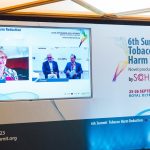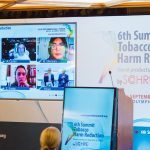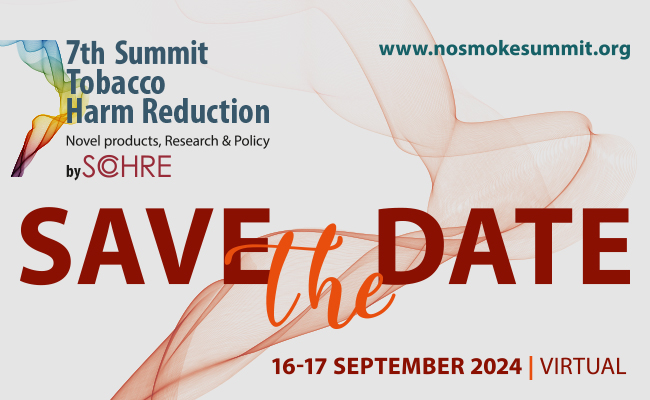Latin America is a very diverse region that comprises 20 countries with total population over 616 million people. Although the discussion on Tobacco Harm Reduction is vivid in the region, advocates face many challenges, mainly because of the extended misinformation and disinformation about the alternative nicotine products, the lack of consistent data about the number and the characteristics of combustible cigarette smokers and electronic devices users, and the different policies used. The current situation regarding harm reduction in Latin America was depicted by four THR specialists from Brazil, Ecuador, and Mexico in an enlightening session, coordinated by Professor Ignatios Ikonomidis and Dr Monica Gorgulho, with the participation of Professor Andrzej Fal, President of the Polish Society of Public Health.
Mrs Zara Snapp, co-founder of the Mexican Instituto RIA, started her speech titled “Prohibition disguised as public health: the case of Mexico” with a short overview of the recent political and legal decisions taken against THR in her country, and said that the Ministry of Health strongly denies that there are fewer risks for smokers from non-combustion. Their attitude, she explained, is very dogmatic: “either you smoke cigarettes and die, or you quit”. Nevertheless, she continued, despite the strict prohibitions, the reality is that there are online sales, as well as unregulated sales, and irregular substances are added to the electronic devices and, as a result, it is very difficult to assure quality controls.
To tackle the lack of research in the field of THR in Mexico, Mrs Snapp said, last year Instituto RIA launched a research project on the current status of the market, that aims to analyze the legal and social context of e-cigarettes and vapes in the country; to conduct surveys in order to explore the reality of people who use these devices and understand their preferences, expectations and positions regarding prohibition; to explore the illegal market and to undertake laboratory analysis of the composition of devices bought in the illegal market, and, finally, to issue documents that compile all this information for different audiences, including media, users, legislators and authorities.
According to the first results of the surveys conducted in users, more than 97% of the respondents reported having smoked before using alternative products and 80% that they no longer smoke traditional cigarettes. 99% of respondents support regulation, while 95% don’t identify any health problems related to their use of nicotine and only 5% reported that they have experienced some problems, including irritation, cough and respiratory issues. Although 61% recognize that there are health risks associated with these devices, Mrs Snapp pointed out, 99% state that prohibition of the devices affects them directly, because of quality issues and because it forces them to return to traditional cigarettes.
According to Instituto RIA’s recommendations, Mrs Snapp concluded, policy reforms must include THR in their strategies to help people reduce the harm caused by smoking. Banning is not the answer, she explained. It is important to dedicate resources to research in order to facilitate greater understanding of the possible benefits of alternative products in smoking cessation, and to educate healthcare professionals regarding THR strategy. You must meet people where they are, she emphasized, not where you want them to be.
In many cases there is a gap between aspirations and reality, Professor Fal commented, and explained that, although according to some publications South America has been the first sub-region of the Americas to accomplish 100% smoke-free environments, the statistics about the smoking population of Chile or Argentina for example―which is over 30% for males―do not imply a smoke-free society. Apparently, if you believe that you live in a smoke-free society, you don’t need to reduce any harm caused by smoking, he said. But we need to face reality; problems don’t disappear because we ignore them―on the contrary, they usually grow.
The more you ban, the more you lead people to the black market and to uncontrolled, possibly more toxic substances, Professor Ikonomidis added. In order to preserve public health, states need to homogenize and check vaping liquids and all new vaping devices.
Speaking about “The health hazards of vaping misinformation and disinformation”, Mr Alexandro Lucian, President of the non-profit organisation DIRETA, said that, according to the American Psychological Association, the spread of misinformation and disinformation has affected our ability to improve public health, as well as to address the climate change, to maintain a stable democracy, and more. In Brazil, he continued, several health organizations and the press, without any scientific evidence, claim that e-cigs must be banned because vaping is the same or worse than smoking and vape contains more nicotine than conventional cigarettes, despite the fact that international health organisations recommend the regulation of e-cigs, and say that vaping is 95% less harmful than smoking and vape is less addictive than conventional cigarettes. Unfortunately, today because of this extensive ‘campaign’ against vaping―Mr Lucian said―8 out of 10 people in Brazil are in favour of a ban on vape.
DIRETA fights against misinformation and disinformation regarding THR in Brazil, presents scientific data and reports that show that vaping is not without risks but is safer than smoking, and that, for an adult smoker who can’t or doesn’t want to quit smoking, vaping can be a good alternative to reduce harm. The organisation also asks legislators to make Brazil follow successful public health policies of other countries.
In Brazil the only way to buy a vaping device is at an illegal market, the speaker noted. Unfortunately, the lack of safety standards and quality control of products sold in these markets is associated with a great fear of contamination, and the risk of buying fake products or using products outside their intended use.
Hopefully, science can’t be ignored forever, Mr Lucian said. The role of initiatives like SCOHRE is very important, since they help to bring scientific information about THR to anyone in the world. DIRETA stays on the side of science, he concluded, and despite the challenges we must continue to share unbiased and technical information, with the goal to prevent diseases and deaths linked to smoking.
In many countries of Europe there is also a hostile environment from medical associations against harm reduction policies, Professor Ikonomidis commented, but there are still ears that want to listen to research data. What we need to pursue is proof of concept that harm reduction policies directly lead to less hospitalizations and less disease.
The problem is that these medical organizations stand against THR without any scientific evidence for their claims, Professor Fal said. The answer to this problem is education, which can increase the level of understanding, but we also must keep in mind that a good education sometimes takes a while to work.
Everyone knows about the problem of the COVID-19 pandemic that has been responsible so far for nearly 6.5 million deaths worldwide; however we should not forget that each year there are more than 7 million deaths directly related to tobacco consumption, Professor Enrique Teran, founding member of the Latin-American network for Tobacco Harm Reduction – RELDAT, said at the beginning of his presentation “Knowledge, attitudes, and practices regarding Tobacco Harm Reduction (THR) in healthcare providers: The case of Ecuador”. Although, according to the statistics, in most of the countries of Latin America and worldwide there is a decrease in tobacco consumption, the true numbers of smokers may be significantly higher due to the illegal commercialization and consumption of tobacco, Dr Teran mentioned.
Following the directions of WHO, many countries refuse to openly discuss about the tobacco harm reduction approach and alternative to combustible cigarettes products that, although not risk-free, there is scientific evidence that they significantly reduce risk. As a result of this practice, he explained, the use of combustible cigarettes in Latin America is much higher than that of alternative non-combustible products.
The refusal of the healthcare community to understand and accept the value of alternative to combustion products is based on their lack of knowledge and misperceptions about the subject, Professor Teran said. According to the results of a survey conducted in Ecuador about the perceptions of healthcare providers regarding THR, 95% of the responders believed nicotine is associated with tobacco-related diseases, 93% reported that nicotine is responsible for lung cancer, 75% stated that e-cigarettes and combustible cigarettes are equally harmful for health, and 81% said that they are equally addictive, while only 17% of the responders said that e-cigarette can be an alternative to reach cessation and 21% were in favour of its use as a complementary tool to cessation.
These disappointing results, Dr Teran concluded, show that it is necessary to educate healthcare professionals, authorities and the public about nicotine, tobacco consumption, and alternatives. Authorities should not take decisions based on lack of scientific information and refuse to even discuss evidence-based policies that can improve public health.
The forth speaker, Mr Miguel Okumura, a Brazilian consumer activist for THR and founder of the Vaporacast project, started his presentation “Communication in times of Prohibition: Empowering consumers to accelerate vaping regulation in Brazil” by saying that he became an advocate for Tobacco Harm Reduction approach, after his successful personal experience to quit smoking by using alternative to cigarette products. Smokers must be informed about all their choices, he said, and information about THR and alternative to combustion products must be shared. It is remarkable how quickly the body recovers from the effects of smoking, he said, adding that flavours are an important issue for people who vape. The role of consumers, especially of persons who managed to quit thanks to the products alternative to traditional cigarettes, is vital since they are the first to share every new information about THR.
In Brazil, between 2017 and 2019, Mr Okumura said, we witnessed the peak of the Brazilian vaping community. People were seeking information about vaping, and it was very common to see new content creators emerging -Vaporacast was one of the many projects launched during this period. A lot of our time and efforts were invested and in return we were able to help many people to stop smoking.
However, in the subsequent years up to the present, these initiatives have faced considerable changes due to restrictions imposed by social media platforms, including those controlled by governmental groups which have been strict regarding vaping-related content. This has resulted in a decline of the vaping community, while an ‘explosion’ of the disposable vapes was witnessed in Brazil. The timing could not have been worse, Mr Okamura explained. Just when vaping was experiencing the fastest growth in the last years in Brazil, the information provided by creators was silenced due to restrictions on social media.
Fortunately, the Vaporacast website content has not been blocked and continues to communicate valuable evidence-based information and real experiences of people who succeeded to quit smoking, through podcasts, and empower consumers to accelerate vaping regulation in Brazil. When there is a strong community, Mr Okumura emphatically said, there is also an assurance that the message will be conveyed. Of course, he added, it is also crucial that all stakeholders are well informed, and especially the journalists who have the power to convey the message to the right audience.
THR activism is a marathon, the speaker concluded, in which consumers―when they are united, organized and well informed―can influence decision makers and promote positive changes. It is crucial that we will continue to educate, collaborate with the media, and adopt creative strategies to assure that the voice of consumers is heard.





